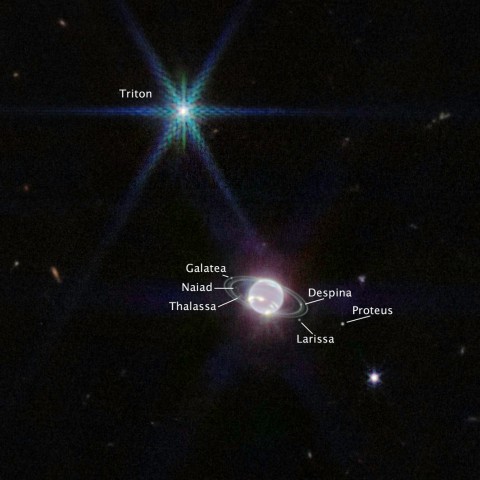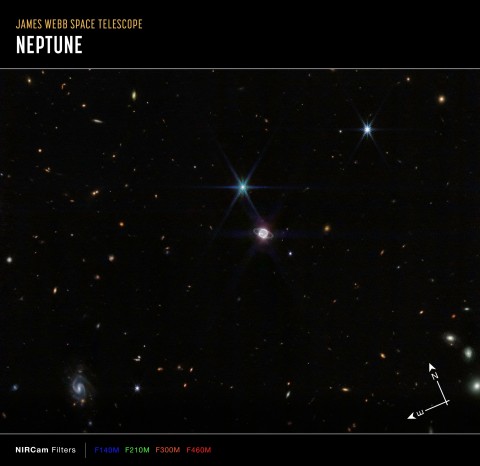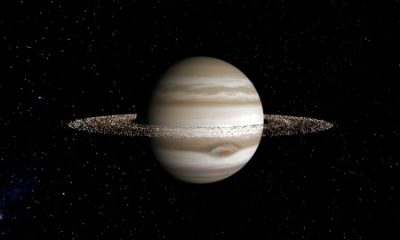Technology
Neptune’s elusive rings pictured by the James Webb Space Telescope

The James Webb Space Telescope is utilized for more than just taking beautiful pictures of the universe’s far reaches.
It’s also been showing off its capabilities closer to home – with its first image of Neptune.
Not only has Webb captured the clearest view of the planet’s rings in more than 30 years, but scientists say its cameras are revealing the ice giant in a whole new light.
Most striking about Webb’s new image is the crisp view of the planet’s dynamic rings – some of which haven’t been seen at all, let alone with this clarity, since the Voyager 2 flyby in 1989.
In addition to several bright narrow rings, the Webb images clearly show Neptune’s fainter dust bands.
Webb’s extremely stable and precise image quality also permits these very faint rings to be detected so close to Neptune.
Webb also captured seven of Neptune’s 14 known moons. Dominating the Webb portrait of Neptune is a very bright point of light sporting the signature diffraction spikes seen in many of Webb’s images; it’s not a star, but Neptune’s most unusual moon, Triton.

Neptune’s moons are also visible in the image
The telescope, an international collaboration with ESA (European Space Agency) and CSA (Canadian Space Agency), provides a unique perspective with its infrared sensitivity on our neighbouring planets.
An ESA Webb statement explains: ‘Neptune has fascinated and perplexed researchers since its discovery in 1846. Located 30 times farther from the Sun than Earth, Neptune orbits in one of the dimmest areas of our Solar System. At that extreme distance, the Sun is so small and faint that high noon on Neptune is similar to a dim twilight on Earth.

A smattering of hundreds of background galaxies, varying in size and shape, appear alongside the Neptune system.
‘This planet is characterized as an ice giant due to the chemical make-up of its interior. Compared to the gas giants, Jupiter and Saturn, Neptune is much richer in elements heavier than hydrogen and helium. This is readily apparent in Neptune’s signature blue appearance in NASA/ESA Hubble Space Telescope images at visible wavelengths, caused by small amounts of gaseous methane.
‘Webb’s Near-Infrared Camera (NIRCam) captures objects in the near-infrared range from 0.6 to 5 microns, so Neptune does not appear blue to Webb. In fact, the methane gas is so strongly absorbing that the planet is quite dark at Webb wavelengths except where high-altitude clouds are present.
‘Such methane-ice clouds are prominent as bright streaks and spots, which reflect sunlight before it is absorbed by methane gas. Images from other observatories have recorded these rapidly-evolving cloud features over the years.

The James Webb Space Telescope was launched on Christmas Day, 2021
‘More subtly, a thin line of brightness circling the planet’s equator could be a visual signature of global atmospheric circulation that powers Neptune’s winds and storms. The atmosphere descends and warms at the equator, and thus glows at infrared wavelengths more than the surrounding, cooler gases.
‘Neptune’s 164-year orbit means its northern pole, at the top of this image, is just out of view for astronomers, but the Webb images hint at an intriguing brightness in that area. A previously-known vortex at the southern pole is evident in Webb’s view, but for the first time Webb has revealed a continuous band of clouds surrounding it.’

-

 Technology2 years ago
Technology2 years agoVoIP Number: Everything You Need To Know
-

 Music2 weeks ago
Music2 weeks ago[Music] Gnash Ft Olivia O’Brien – I Hate you, I Love you
-

 Music2 weeks ago
Music2 weeks ago[INSTRUMENTAL] John Legend – All Of Me
-

 Music3 weeks ago
Music3 weeks agoAlan Walker – Faded [INSTRUMENTAL]
-

 Music2 weeks ago
Music2 weeks ago[Video] 21 Savage ft. Offset & Metro Boomin – Rap Saved Me
-

 Music2 weeks ago
Music2 weeks ago[Instrumental] Wiz Khalifa – See You Again ft. Charlie Puth
-

 ANE Stories3 months ago
ANE Stories3 months ago[STORY] AMAKA THE LESBIAN (Complete Episodes)
-

 Music3 weeks ago
Music3 weeks ago[Music] Akon – Sorry Blame It On Me















































